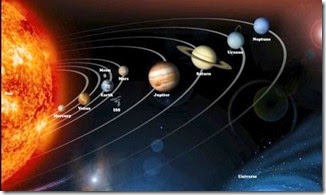Tuesday 19 May 2015
Solar System
The solar system is made up of the Sun, the 8 planets and 5 dwarf planets and their 176 known moons,asteroids, comets, dust and gas. The planets, asteroids, and comets travel around the Sun. Sun is the centre of our solar system. Most of the bodies in the solar system travel around the Sun along nearly circular(elliptical) paths or orbits, and all the planets travel about the Sun in the anticlockwise direction.
The Solar system is located in the Milky Way Galaxy.
Formation of Solar System
The formation of the Solar System began 4.6 billion years ago with the gravitational collapse of a small part of a giant molecular cloud. Most of the collapsing mass collected in the centre, forming the Sun, while the rest flattened into a proto planetary disk out of which the planets, moons, asteroids, and other small Solar System bodies formed.
This widely accepted model, known as the nebular hypothesis, was first developed in the 18th century by Emanuel Swedenborg,Immanuel Kant, and Pierre-Simon Laplace. Its subsequent development has a variety of scientific disciplines including astronomy, physics, geology, and planetary science. Since the dawn of the space age in the 1950s and the discovery of extra solar planets in the 1990s, the model has been both challenged and refined to account for new observations.
Scientists believe that the solar system was formed when a cloud of gas and dust in space was disturbed, maybe by the explosion of a nearby star (called a supernova). This explosion made waves in space which squeezed the cloud of gas and dust. Squeezing made the cloud start to collapse, as gravity pulled the gas and dust together, forming a solar nebula. Just like a dancer that spins faster as she pulls in her arms, the cloud began to spin as it collapsed. Eventually, the cloud grew hotter and denser in the center, with a disk of gas and dust surrounding it that was hot in the center but cool at the edges. As the disk got thinner and thinner, particles began to stick together and form clumps. Some clumps got bigger, as particles and small clumps stuck to them, eventually forming planets or moons . Near the center of the cloud, where planets like Earth formed, only rocky material could stand the great heat. Icy matter settled in the outer regions of the disk along with rocky material, where the giant planets like Jupiter formed. As the cloud continued to fall in, the center eventually got so hot that it became a star, the Sun, and blew most of the gas and dust of the new solar system with a strong stellar wind. By studying meteorites, which are thought to be left over from this early phase of the solar system, scientists have found that the solar system is about 4600 million years old!
Formation of planets
The various planets are thought to have formed from the solar nebula, the disc-shaped cloud of gas and dust left over from the Sun's formation. The currently accepted method by which the planets formed is accretion, in which the planets began as dust grains in orbit around the central proto star. Through direct contact, these grains formed into clumps up to 200 metres in diameter, which in turn collided to form larger bodies (planetesimals) of ~10 kilometres (km) in size.These gradually increased through further collisions, growing at the rate of centimetres per year over the course of the next few million years.
The inner Solar System, the region of the Solar System inside 4 AU, was too warm for volatile molecules like water and methane to condense, so the planetesimals that formed there could only form from compounds with high melting points, such as metals (like iron, nickel, and aluminium) and rocky silicates. These rocky bodies would become the terrestrial planets(Mercury, Venus, Earth, and Mars). These compounds are quite rare in the Universe, comprising only 0.6% of the mass of the nebula, so the terrestrial planets could not grow very large.The terrestrial embryos grew to about 0.05 Earth masses (M⊕) and ceased accumulating matter about 100,000 years after the formation of the Sun; subsequent collisions and mergers between these planet-sized bodies allowed terrestrial planets to grow to their present sizes.
When the terrestrial planets were forming, they remained immersed in a disk of gas and dust. The gas was partially supported by pressure and so did not orbit the Sun as rapidly as the planets. The resulting drag caused a transfer of angular momentum, and as a result the planets gradually migrated to new orbits. Models show that density and temperature variations in the disk governed this rate of migration, but the net trend was for the inner planets to migrate inward as the disk dissipated, leaving the planets in their current orbits.
The giant planets (Jupiter, Saturn, Uranus, and Neptune) formed further out, beyond the frost line, the point between the orbits of Mars and Jupiter where the material is cool enough for volatile icy compounds to remain solid. The ices that formed the Jovian planets were more abundant than the metals and silicates that formed the terrestrial planets, allowing the giant planets to grow massive enough to capture hydrogen and helium, the lightest and most abundant elements.Planetesimals beyond the frost line accumulated up to 4 M⊕ within about 3 million years.Today, the four giant planets comprise just under 99% of all the mass orbiting the Sun.
Theorists believe it is no accident that Jupiter lies just beyond the frost line. Because the frost line accumulated large amounts of water via evaporation from in falling icy material, it created a region of lower pressure that increased the speed of orbiting dust particles and halted their motion toward the Sun. In effect, the frost line acted as a barrier that caused material to accumulate rapidly at ~5 AU from the Sun. This excess material coalesced into a large embryo (or core) on the order of 10 M⊕, which began to accumulate an envelope via accretion of gas from the surrounding disc at an ever increasing rate.Once the envelope mass became about equal to the solid core mass, growth proceeded very rapidly, reaching about 150 Earth masses ~105 years thereafter and finally topping out at 318 M⊕.Saturn may owe its substantially lower mass simply to having formed a few million years after Jupiter, when there was less gas available to consume.
Taurus stars like the young Sun have far stronger stellar winds than more stable, older stars. Uranus and Neptune are thought to have formed after Jupiter and Saturn did, when the strong solar wind had blown away much of the disc material. As a result, the planets accumulated little hydrogen and helium—not more than 1 M⊕ each. Uranus and Neptune are sometimes referred to as failed cores.The main problem with formation theories for these planets is the timescale of their formation. At the current locations it would have taken a hundred million years for their cores to accrete. This means that Uranus and Neptune probably formed closer to the Sun—near or even between Jupiter and Saturn—and later migrated outward (see Planetary migration below). Motion in the planetesimal era was not all inward toward the Sun; the Stardust sample return from Comet Wild 2 has suggested that materials from the early formation of the Solar System migrated from the warmer inner Solar System to the region of the Kuiper belt.
After between three and ten million years,the young Sun's solar wind would have cleared away all the gas and dust in the proto planetary disc, blowing it into interstellar space, thus ending the growth of the planets.
A Video for children




No comments :
Post a Comment